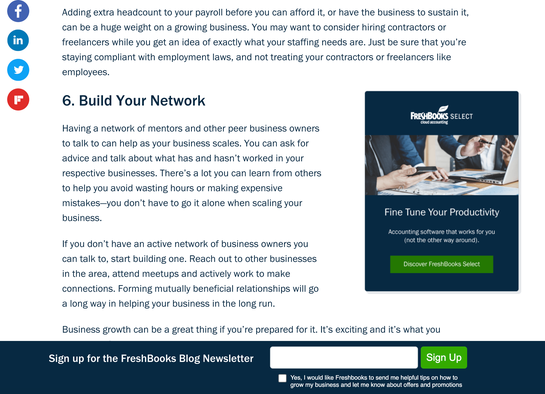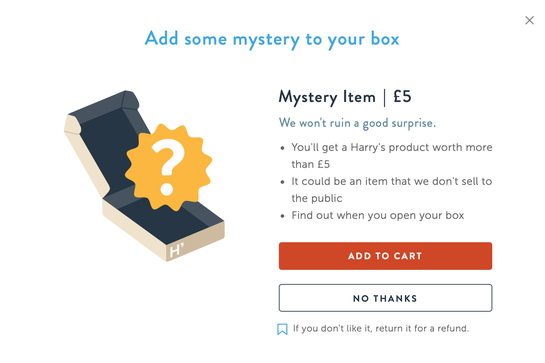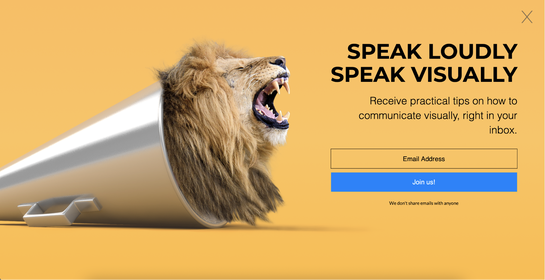Why AdRoll is Your Ideal Programmatic DSP
AdRoll helps you run full-funnel, multi-channel ad campaigns. Learn how our programmatic DSP enables better ad campaigns that convert customers.
Read More
Pop-up ads aren't exactly the most popular with consumers, and for a good reason: they're often intrusive to the browsing experience. But marketers today still use pop-up ads because they're effective.
According to Sumo, a basic pop-up ad can convert at least 3% of average viewers, and they also have excellent conversion and click-through rates. These viewers clicked the pop-up, either signed up, became leads, or even purchased the product or service.
Instead of using intrusive pop-ups, savvy digital marketers need to learn how to create exciting and irresistible pop-ups. Here's how.
Nothing grabs a customer's attention better than the word "free." Whatever you're offering — an ebook, discount, or tutorial videos — you should add an image that displays that offer in the pop-up.
You can grab their attention and pique their interest with limited time offers as well. Consider setting a limit to your "freemium" resources to appeal to their sense of urgency. If you're looking to get more newsletter sign-ups, you can offer a discount coupon or similar things to viewers who convert.
Viewers may not be clicking on your ads because you aren't using the right pop-up ad format. You're probably familiar with full-screen pop-ups or banners that take up a large chunk of the screen. Slide-in ads are less intrusive and scroll into the screen, usually from the side.
You can also boost your email marketing subscriber sign-ups by using an exit pop-up. An exit pop-up is triggered whenever it detects that a visitor on your website is about to leave. You can offer a free resource for visitors who subscribe and click on the ad before they go.
Or you can use more subtle ad formats, like ribbons and pop-ups that are embedded on your blog. These tend to be less intrusive to your site's overall user experience and can be very eye-catching when designed correctly.
Image: Examples of subtle bottom ribbon pop-up ads on the Freshbooks blog
Marketers know the value of choosing the right words to optimize the effectiveness of copy. Using the right prompts can reduce your bounce rate and encourage them to agree.
Instead of an option to just say "no," you can get creative with ways to urge your visitors to rethink the offer:
Image: Harry’s
Adding attractive visual cues and images can draw the viewer's attention to the pop-up. You can also choose a light or dark background which stands out or contrasts with the rest of the page and can emphasize your CTA.
Depending on your brand identity, you can even opt for GIFs, memes, or other eye-catching graphics, leading to more sign-ups. The visuals for your exit pop-ups should trigger urgency, interest, and connection with the viewers. You'd want something that your viewers would remember about your website.
Image: Visme
FOMO, or the Fear Of Missing Out, doesn't just affect a grounded kid who can't go to the mall with their friends. Nobody wants to be out of the loop. Whenever a limited edition product or service is announced, consumers are bound to sign up or make a purchase immediately.
You can also use FOMO in your pop-up ads by offering resources to a limited number of visitors who sign up or make a purchase within a certain period. Invite-only offers also encourage your customers to share your brand on social media and get others to feel the FOMO.
Be sure that you're making it evident in your copy that this offer isn't going to be available forever. That way, users are more likely to convert if they know this is the only chance they have to cash in on your offer.
Online privacy may sound like an oxymoron. However, it's a significant concern people have the moment they start using the internet. The last thing that they want is for brands to start stalking them everywhere immediately after visiting their site or filling up a form.
That's the reason why the first thing most of your site visitors do before they start surfing the web is set their browsers to incognito mode and activate their VPNs. This helps add an added layer of protection to ensure their personal information stays safe and secure.
So if you want to create irresistible pop-up ads your visitors want to click, you need to make sure that you take the necessary steps to show that you still respect their privacy.
Start by making your pop-up ads less intrusive by including a close button to your pop-ups if a viewer wants to opt-out. Then, customize your pop-up's frequency based on your segmentation of website visitors. If a visitor already signed up using your pop-up, you don't have to show them the same pop-up ad the next time they visit your website.
Including a disclosure notice to your pop-up ad forms is another way to show them that you value their privacy. Add a checkbox that signifies that they consent to receive future communication from you, such as emails.
Also, make sure your pop-up forms and ads also show links to your Terms and Conditions page as well as your Privacy Policy so that users know exactly how your business is using their data.
Repetitive and all-too-frequent pop-up ads often turn visitors off. That doesn't mean you're not supposed to make follow-ups or repeat offers —you just have to segment your subscribers and customers into better groupings with different messages.
By practicing segmentation, you offer targeted messages to those who find these valuable. For example, you don't have to send subscription reminders to visitors who already signed up. You can send them follow-ups to discounts or offers instead.
Consider collecting better and more detailed information like birthdays and other relevant demographic data from your visitors. This way, you can send them better-targeted ads that they will be interested in.
When so many brands and publications are using pop-up ads, sometimes the best way to stand out is to, well, stand out.
People enjoy brands with personality, so if your brand is different than others out there, use that to your advantage. This serves to set you apart from the regular, formal brand in your niche that isn't very memorable in the long run.
Also, design your ad so that users know that it's actual people behind the ads they're seeing. No one wants to be addressed like they aren't a human being with real needs, concerns, and desires, and vice versa: no one wants to be engaging with bots all the time.
Allow your brand's voice to shine through, and let your customers know that you're truly a brand that wants to connect with them as a person.
Finally, when it comes to your pop-up ads, A/B testing is an essential and necessary part of your campaign and just about any marketing strategy. There are several online tools for A/B testing that you can use to measure how certain groups of people respond to your ads.
Make A/B testing a habit by tweaking every aspect of the pop-up ads like the design, placement, copy, timing, and offers. A/B testing lets you keep track of which messages are more effective for increasing traffic, reducing bounce rate, getting conversions, and improving your website's experience.
As a best practice, only tweak one element at a time before you explore others. This way, you can weigh results more clearly and identify what factors contributed to the winning result.
Exit pop-ups, if properly executed, can significantly improve the conversion rate on your website. As you monitor how visitors respond to your ads, you can determine which strategies work best and which messages you should abandon.
While digital marketers may have to upskill to keep up with the latest trends, don't hesitate to get professional help for your data analysis needs. Depending on how much data and traffic you have on your site, you should consider running an A/B test longer, as mentioned in the previous tip, to see if your results are affected by other factors.
Pop-up ads don't have to be the reason your visitors leave your site. If done correctly, pop-up ads can significantly improve your conversions and be an effective strategy in your marketing campaign. For more ways on how to optimize pop-ups to hack growth, check out AdRoll today.
Last updated on October 28th, 2022.


